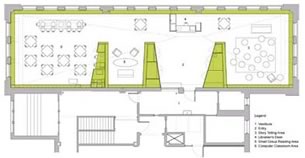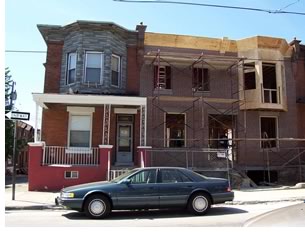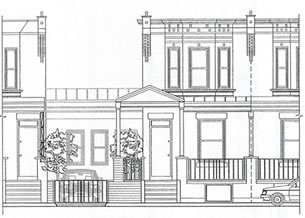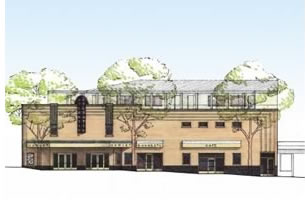

08/2005
by Jonathan Moore
It’s a truism worth remembering: Giving one’s time and talents to others begets unexpected rewards. Moreover, for architects as well as all professionals, pro bono work is an integral component of professional practice. As the AIA Code of Ethics & Professional Conduct states, “Members should render public interest professional services and encourage their employees to render such services.” Thus, it is no surprise that AIA members, through their components and architectural foundations, have organized to provide communities with abundant pro bono services.
 Pro bono services are those rendered without compensation or expectation
of a fee for the public good. There are rewards, however, both tangible
and intangible, not the least of which is the satisfaction of giving
back to the community. On a more material level, pro bono work brings
with it increased firm-name recognition, a better public understanding
of the value of the profession in general, valuable strategic contacts,
and overall, therefore, business development.
Pro bono services are those rendered without compensation or expectation
of a fee for the public good. There are rewards, however, both tangible
and intangible, not the least of which is the satisfaction of giving
back to the community. On a more material level, pro bono work brings
with it increased firm-name recognition, a better public understanding
of the value of the profession in general, valuable strategic contacts,
and overall, therefore, business development.
With increased attention to benefits derived by the general public, pro bono practice is making its mark from coast to coast. For example, architects are revitalizing neighborhoods, schools, and parks in our nation’s capital under the AIA/DC Community Design Services (CDS) program. Directed by the chapter’s Washington Architectural Foundation (WAF), CDS pairs architects with local nonprofits to prepare preliminary designs and other forms of technical assistance. Expert guidance includes cost estimates, zoning analysis, conceptual models, and other visionary ideas for structural and landscape renewal. “CDS is a key component of our outreach mission,” says WAF Board President Stephen J. Vanze, AIA. “Through its collaborative efforts, architects are restoring many of Washington’s hidden treasures.”
A spirit of brotherly love is abundant in greater Philadelphia as well, with architects, engineers, and other design professionals volunteering with the Community Design Collaborative. Created by a handful of volunteers in 1991, the collaborative began as a special initiative of AIA Philadelphia, became an independent nonprofit entity in 1996, and currently places more than 100 design professionals with local nonprofits each year. The collaborative offers preliminary design assistance such as structural and mechanical assessments, conceptual design, cost estimates, and programming and space planning. Each year the collaborative provides an estimated $5,000 to $15,000 in non-billed services. Like CDS, the collaborative provides architects with outlets to test and convey their visions for community environmental renewal.
In some cases, projects under both programs can lead to actual billable work. “Design firms support the collaborative because it offers professional development and the chance to bring design into the neighborhood arena,” says Beth Miller, the collaborative’s executive director. “Our volunteers’ early involvement provides leverage for additional grants and services that take the project to the next step in the development process.”
Serving the public
In San Francisco, pro bono requests from Bay Area nonprofits were piling
up on the desk of John Peterson, principal of Peterson Architects.
(See the member spotlight). Receiving
a broad spectrum of project requests, Peterson discovered his firm’s
pro bono workload began exceeding billable orders. This resulted in
his firm’s creation of Public Architecture, a 501(c)3 nonprofit
organization putting architectural resources in the service of the
public interest. Offering creative solutions for practical problems
associated with the built environment, Public Architecture seeks to
move architecture beyond time-honored guidelines of conventional practice,
providing a stable venue for experimentation and exploration.
 “Public
Architecture’s nonprofit clients are often initial
recipients of new ideas and design concepts,” says Peterson. “Its
operating structure helps design professionals become more proactive
with problem identification and creative solutions through innovative
research, new technologies, and creative application concepts.” Rather
than waiting for commissions with predefined tasks, a central tenet of
Public Architecture’s mission is creating more of a leadership
role for architects as problem identifiers—complementing their
more established role as problem solvers. Peterson believes pro bono
work will help architects remain competitive with other professions well
known for community service. “Architects nationwide are contributing
in many ways to benefit our daily lives,” he adds. “We
just need to leverage more instances of public recognition in support
of our efforts.”
“Public
Architecture’s nonprofit clients are often initial
recipients of new ideas and design concepts,” says Peterson. “Its
operating structure helps design professionals become more proactive
with problem identification and creative solutions through innovative
research, new technologies, and creative application concepts.” Rather
than waiting for commissions with predefined tasks, a central tenet of
Public Architecture’s mission is creating more of a leadership
role for architects as problem identifiers—complementing their
more established role as problem solvers. Peterson believes pro bono
work will help architects remain competitive with other professions well
known for community service. “Architects nationwide are contributing
in many ways to benefit our daily lives,” he adds. “We
just need to leverage more instances of public recognition in support
of our efforts.”
All they ask is one percent
Inspired by formalized systems in the legal and medical professions encouraging
pro bono service, Public Architecture launched its One
Percent Solution program on April 1. Led by Executive Director
John Cary, Assoc. AIA, the One Percent Solution challenges architecture
firms and individual practitioners to dedicate a minimum one percent
of their working hours to pro bono service annually. Growing from Cary’s
belief that design professionals lack encouragement and support nationwide
needed to record pro bono work, the One Percent Solution establishes
measurement goals itemizing architecture’s contributions to their
states and localities. “Pro bono should be viewed not as free, but for the public good,” says Cary.
 Public
Architecture calculates that one percent of the standard 2,080-hour work
year would total 20 pro bono hours per annum, representing a “modest,
but not trivial, individual contribution to the public good,”
according to Peterson. Cary readily acknowledges certain nuances associated
with pro bono practice: documenting non-billable hours, pursuing untested
design concepts, and greater reliance on Good Samaritan liability laws
to name a few. With rewards outnumbering potential liabilities, Public
Architecture believes pro bono work promotes an intrinsic value of practice,
as well as political clout vis-à-vis other licensed professions. “Adoption
of One Percent’s goals and objectives by firms large and small
will further enhance architecture’s ability to compete in the public
relations and public policy arenas,” Cary adds.
Public
Architecture calculates that one percent of the standard 2,080-hour work
year would total 20 pro bono hours per annum, representing a “modest,
but not trivial, individual contribution to the public good,”
according to Peterson. Cary readily acknowledges certain nuances associated
with pro bono practice: documenting non-billable hours, pursuing untested
design concepts, and greater reliance on Good Samaritan liability laws
to name a few. With rewards outnumbering potential liabilities, Public
Architecture believes pro bono work promotes an intrinsic value of practice,
as well as political clout vis-à-vis other licensed professions. “Adoption
of One Percent’s goals and objectives by firms large and small
will further enhance architecture’s ability to compete in the public
relations and public policy arenas,” Cary adds.
Notable examples
A visit to the One Percent Solution
Web site reveals architecture’s
creative imprimatur on a variety of projects. For Hands-On Atlanta, a
nonprofit volunteer placement group, an unscheduled move led to “charrette-like” purchase
of an old seafood distribution warehouse. Roy Abernathy, AIA, and his
team with Atlanta’s
Jova/Daniels/Busby Architects offered to help. Abernathy and his crew
outlined what he terms a “low-impact comprehensive plan taking
advantage of the idiosyncrasies and unusual character of the building.”
 Transforming a fish warehouse facility to administrative offices included
installation of high-efficiency light fixtures, overhauling water and
ventilation systems, and use of “gently worn” carpet and
furniture from major corporate donors. Abernathy extols pro bono’s
virtues, believing it establishes “collateral credibility” for
design professionals on many levels. In his view, this credibility translates
into more effective advocacy before zoning boards, code enforcement agencies,
urban planning councils, and other design and construction sectors.
Transforming a fish warehouse facility to administrative offices included
installation of high-efficiency light fixtures, overhauling water and
ventilation systems, and use of “gently worn” carpet and
furniture from major corporate donors. Abernathy extols pro bono’s
virtues, believing it establishes “collateral credibility” for
design professionals on many levels. In his view, this credibility translates
into more effective advocacy before zoning boards, code enforcement agencies,
urban planning councils, and other design and construction sectors.
And in the nation’s capital
In Washington, D.C., preliminary plans call for converting an abandoned
1950s-era movie theater into a multipurpose community center thanks
to a CDS team led by Leora Mirvish, AIA, of Quinn Evans Architects.
Working with D.C.’s Far Southwest-Southeast Community Development
Corporation, 12,000 square feet of existing space would be remodeled
into retail shops, small offices, and rooms with retractable walls
for community events. Blueprints even include adding four one-bedroom
rooftop apartments. Another CDS volunteer, Carlisle S. Bean, AIA, is
providing conceptual interior/exterior upgrades to an 80-year-old semi-detached
row house on behalf of MOMMIES TLC (Mentors of Minorities in Education),
which provides after-school and summer programs for disadvantaged children
in Washington’s Columbia Heights neighborhood.
 Bean’s
efforts include checklists for zoning, life-safety, building code, and
ADA-accessibility requirements, and a schematic design for expansion,
which could incorporate recycled or donated materials such as steel posts
and beams. In the spirit of sustainable design, he is also advocating
grass-covered rooftop areas, rainwater entrapment, and possibly, solar
water heating. These proposed additions could help qualify for LEED™ certification
by the U.S. Green Building Council, making this row house a notable
architectural model as well as a first-rate learning center for children
and the neighborhood.
Bean’s
efforts include checklists for zoning, life-safety, building code, and
ADA-accessibility requirements, and a schematic design for expansion,
which could incorporate recycled or donated materials such as steel posts
and beams. In the spirit of sustainable design, he is also advocating
grass-covered rooftop areas, rainwater entrapment, and possibly, solar
water heating. These proposed additions could help qualify for LEED™ certification
by the U.S. Green Building Council, making this row house a notable
architectural model as well as a first-rate learning center for children
and the neighborhood.
A project manager with Washington’s WDG Architecture PLLC, Bean is a seasoned pro bono veteran, having participated in AIA Regional Urban Design Assistance Teams (R/UDAT). He views pro bono work as essential for building public appreciation of the true scope and complexities of the profession. “Architects are not just designers, but an integral part of the entire building process,” he says, pointing out the keen eye and unique approach design professionals contribute to their client’s objectives. Bean volunteered for CDS at the urging of WDG principal C.R. George Dove, FAIA, an ardent proponent of community outreach and former president of the Washington Architectural Foundation.
You can do it, too
Benefiting from increased public exposure as new ideas come to life has
many architect’s singing pro bono praises. Through programs like
Community Design Services, the Community Design Collaborative, and
Public Architecture, cost analysis and image projections are being
transformed into virtual reality. “CDS serves as a catalyst for
concept projects that might not otherwise be considered,” says
Mary Fitch, AICP, WAF executive vice president and AIA/DC executive
director. “Expanding community outreach to local nonprofits is
what energizes our foundation, and through CDS, these activities provide
tangible blueprints for fundraising initiatives, while showing other
potential stakeholders a project’s future potential.”
Copyright 2005 The American Institute of Architects.
All rights reserved. Home Page ![]()
![]()
